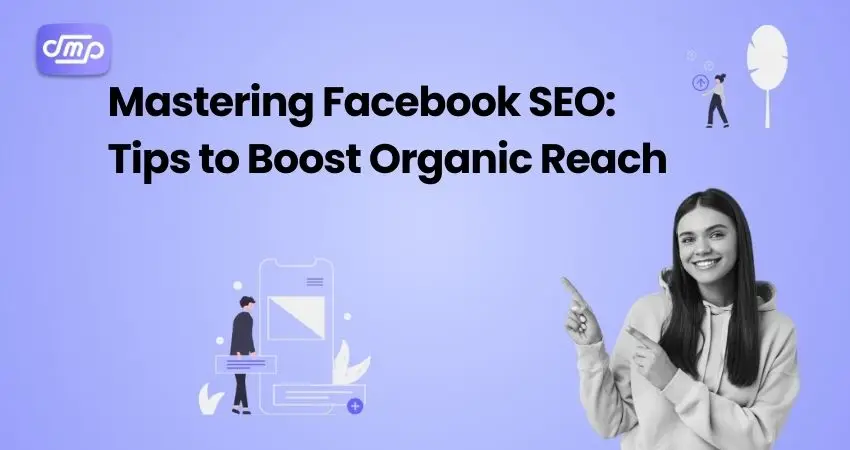
- November 7, 2024
- Digital Marketing, graphic design, seo
- Search Engine Optimisation (SEO)
Table of Contents
In today’s digital landscape, SEO isn’t just for search engines like Google; social media sites like Facebook now use SEO. Facebook SEO is the process of optimizing your page, content, and engagement methods to increase exposure in Facebook’s search results and news feed. With billions of users every day, Facebook provides a major potential for businesses, brands, and creators to engage with their target audience and enhance organic reach.
The significance of Facebook SEO has increased as organic reach on the platform has gotten increasingly difficult to acquire. Facebook’s algorithm emphasizes posts that are relevant, engaging, and timely, so if your updates are not optimized, just a small percentage of your followers will see them. Using efficient SEO methods on Facebook, you may improve how Facebook allows you to increase the frequency and reach of your content, create a stronger brand presence, and ultimately generate more visitors and engagement to your page.
Optimizing Your Facebook Page for SEO
Optimizing your Facebook page for SEO is a series of smart measures that will help your page appear in search results on Facebook and, in some situations, on search engines such as Google. By focusing on page setup, keywords, and content organization, you may increase your page’s visibility and attract more followers naturally. Here is how to start:
1. Select an effective page name and username
One of the most common ways people find you on Facebook is through your page name. Your page’s username (or handle) appears in the URL and should correspond to your brand name. This constancy makes things easier for folks.
2. Fill out your "About" section with relevant keywords
The “About” area on Facebook is crucial for SEO. Use this field to write a concise, keyword-rich description of your company and the services or goods you provide. Incorporate your major keyword (e.g., “Facebook SEO”) naturally into your description, but avoid keyword stuffing. If your firm is locally focused, include your location to increase local search visibility.
3. Select the appropriate categories and subcategories
Facebook lets you select a category and subcategories that describe your business type. Selecting the most accurate categories will allow Facebook to recommend your page to others who are interested in related material, increasing your organic reach.
4. Include contact information and key
Provide correct contact information (address, phone number, and website link) and update it as needed. These facts are especially critical for firms with physical locations because they improve local SEO and believability. If you have business hours, include those as well; Facebook prefers sites with thorough and honest information.
5. Use high-quality profile and cover photos
Ensure that your profile and cover photos are high-quality, professional, and relevant to your brand. Your profile picture is frequently your emblem, whereas your cover photo can be a visual depiction of your current offerings or a compelling image related to your business. This can make your photographs more accessible while also improving SEO.
6. Include keywords in your posts and updates
Incorporate important keywords naturally into your posts. These keywords should be relevant to your sector or issues of interest to your target audience. Be wary of overusing keywords, as Facebook’s algorithm prefers material that appears natural and interesting over heavily keyword-focused postings.
7. Include call-to-action buttons
Facebook lets you include a call-to-action (CTA) button on your page, such as “Shop Now,” “Sign Up,” or “Contact Us.” To boost user engagement and conversions, select a CTA that is relevant to your business goals. This helps to drive activities that Facebook can track. Driving actions that Facebook can track, hence increasing your page’s prominence.
8. Allow reviews for social proof
Positive feedback boosts your trustworthiness and improves your page’s searchability. Enabling reviews on your Facebook page allows satisfied consumers to offer their feedback, which adds crucial social proof. Respond to evaluations to demonstrate engagement and appreciation. This can inspire more followers to engage with your page, allowing the algorithm to recognize your material as valuable.
9. Pin important posts
Pinning a post keeps it at the top of your feed, so visitors see it first. Use this function to showcase important announcements, promotions, or popular material that reflects your brand well. Keeping relevant, high-value items at the top can improve engagement and signal to Facebook that your page is active and worth promoting.
10. Consistently update your page with new content
An active page tells Facebook’s algorithm that your brand is engaged and relevant. Keep your page fresh and enticing by posting updates, sharing news, and engaging with fans on a regular basis. Consistent updating not only keeps your fans engaged, but it also helps Facebook recognize your page as a trustworthy source of information.
Best Practices for Facebook Content SEO

Creating content optimized for Facebook SEO is critical for increasing organic reach and engaging your audience. Because Facebook’s algorithm values relevance and engagement, using successful content tactics can help your posts reach a larger audience and drive conversation. Here are some excellent practices for optimizing and increasing the visibility of your Facebook content:
- Create keyword-optimized posts: Use keywords that are relevant to your audience’s interests and your brand’s focus. Research common terms in your niche and use them naturally in your content. Use keywords in key areas. Increase discoverability by using relevant keywords in your posts’ text, captions, and hashtags. While Facebook does not function in the same way as a typical search engine, keywords do assist the algorithm understand the context of the article.
- Use Multimedia for Increased Engagement: Facebook prefers posts with multimedia content, particularly native video uploads, which tend to produce more engagement. Use high-quality photographs, graphics, and videos to make your content more engaging. Because live videos allow for real-time interaction, they frequently have a better reach and engagement. To directly engage your audience, use Facebook Live for Q&A sessions, behind-the-scenes glimpses, or product demonstrations.
- Post at the optimal times for maximum reach: Use Facebook Insights to figure out when your audience is most active and likely to notice your content. Posting at appropriate times enhances the likelihood of increased initial engagement, which can help your material reach a wider audience. Regular updating keeps your page active and encourages followers to interact with your material. An active posting schedule indicates to Facebook’s algorithm that your page offers continual value.
- Use hashtags: While hashtags are not as effective on Facebook as on Instagram, they can still help your posts reach a larger audience when used carefully. Use relevant and branded hashtags to boost discoverability without cluttering your content. Overusing hashtags can make messages appear spammy and detract from the core topic.
- Encourage interaction and engagement: Encourage followers to participate by asking questions that elicit comments, shares, or reactions. Responding to followers’ remarks not only strengthens the community, but also increases engagement. The system emphasizes postings with active conversations.
- Create shareable and valuable content: Share Tips, Tricks, and Educational Content. Posts containing value (such as how-tos or helpful advice) are more likely to be saved, shared, and interacted with. Content that educates or solves an issue for your audience is likely to do well. Encourage followers to take action, such as visiting your website, trying out a new product, or sharing the message with their friends. CTAs can enhance the likelihood of interaction. Increase the likelihood of interaction and help you meet your content objectives.
- Utilize stories and reels: Facebook Stories display at the top of the news feed and are an excellent way to keep your page fresh with regular updates. They also offer a more casual approach to connecting with your audience and increasing engagement. Reels are popular for short, engaging films and can help you reach a larger audience. Experiment with reels by sharing quick advice, highlights, or behind-the-scenes footage to attract viewers.
- Make Use Of Links Include links to relevant pages: When sharing links, make sure they are appropriate for your content and audience. Avoid sharing too many links, as Facebook’s algorithm may deprioritize postings. Deprioritize postings that contain external links. When sharing links, use Facebook’s link preview feature to offer followers an idea of what the link includes. This improves the post’s visual attractiveness and can raise click-through rates.
- Monitor Performance and Improve Your Strategy: Regularly use Facebook Insights to track the performance of your posts. Track key data such as engagement rate, reach, and click-throughs to determine which sorts of content are most effective.
Tracking and Analyzing Facebook SEO Success

To assess the efficiency of your Facebook SEO activities, you must track and analyze performance metrics. These insights highlight what is effective, where there is space for development, and how to fine-tune your content strategy. By focusing on key indicators, you may improve your Facebook and website presence and organic reach over time. Here’s how to successfully track and assess your Facebook SEO success:
When sharing links on Facebook, keep track of how many times users click through to your website or other associated material. A high CTR indicates that your call-to-action is effective and your content is appropriate for your audience.
- Facebook Analytics: If available, you can utilize Facebook Analytics (while it has been phased down, similar data may be available through Meta Business Suite) to analyze link clicks and identify audience activity on your website.
- Google Analytics: Use UTM parameters on links to monitor how much traffic Facebook sends to your website, and then evaluate the visits in Google Analytics to assess the quality of Facebook-generated traffic.
To discover how effective pinned posts are at increasing visibility and interactions, compare their engagement numbers to those of your regular posts.
Conclusion
Mastering Facebook SEO is critical for increasing your organic reach and establishing a strong online presence. Understanding Facebook’s algorithm, optimizing your page and content, and continuously measuring key performance indicators will help you increase your page’s visibility and interaction. Implementing best practices for content development, leveraging multimedia, and tracking follower growth are all part of a data-driven approach that maximizes your reach.
As you tweak your Facebook SEO approach, keep in mind that consistency and flexibility to audience behavior are essential. With an emphasis on creating meaningful, engaging material, you’ll position your page to flourish in the ever-changing social media market, generating long-term connections and organic brand growth.











